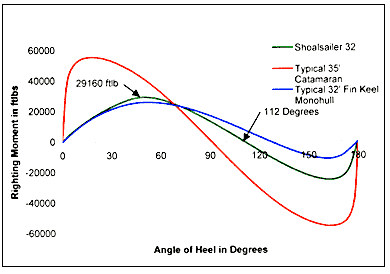Did you guys see this on the homepage?
makes one wonder why sane men ever want to go to sea for a living?
of course, I came to realize that I was not sane at all but there was nothing I could do about it so remained at sea for my whole career!
I wonder what language the song is in? Could it be Croatian? Lord knows those men aren’t sane at all!
Took a 42 degree off cape hatteras few winters back. Not fun.
Can’t believe gCaptain got sucked into the weather channel storm naming scam …
So how far is too far? Is their a program onboard to plug in cargo loading and fuel to get a stability number?
I have one run for my boat showing stability out to about 125 degree or so. I am guessing this ship is less.
125 degrees? That’s capsized in my book.
Yes, cargomax is one frequently used.
We have a program onboard that does stability modeling based on our cargo and current displacement. Our engineering officer monitors it so that we can ballast accordingly for weather and operations. We can also account for effects of wind and ice accumulation.
Granted, we operate in the Gulf of Alaska and Bering Sea; where weather is always shitty and virtually unpredictable.
Yes, tell me how stability can even be imagined out to 125 degrees? You are halfway between upside down and laying on your side. Do you mean 62.5 degrees in each direction?
[QUOTE=“justaboatdriver;127833”]
Yes, tell me how stability can even be imagined out to 125 degrees? You are halfway between upside down and laying on your side. Do you mean 62.5 degrees in each direction?[/QUOTE]
Right, I would think deck edge immersion would be a consideration by then, yeah?
[QUOTE=awulfclark;127836]Right, I would think deck edge immersion would be a consideration by then, yeah?[/QUOTE]
Yes this is fact…if a hull is 100% watertight in all respects and there is no shifting of cargo, a vessel can roll past the point of deck edge immersion and maintain positive righting arm. What happens though is that after that point of inclination righting arm decreases rapidly until is reaches zero and then you turn turtle and stay that way like in the “Poseidon Adventure” floating on the air trapped in the overturned hull.

Of course, no vessel is 100% watertight at all angles of inclination with the possible exception of a submarine and there is no way in hell the cargo can be prevented from shifting unless it us a bulk carrier filled with styrofoam peanuts or pingpong balls!
No - 125% each way. This is not unusual for lead-ballasted sailboats. Back before the current trend of “fat-ass” sailboat designs it was pretty much assumed that sailboats were self-righting, or maybe self-sinking if the hatches are open. Remember half the weight of a lead-ballasted sailboat can be lead beneath the hull, so even lying over 90 degrees there is a lot of righting moment.

My own boat is between the green and blue curves. Note this assumes no sails are up. I have been aboard a racing boat with less than I would like stability and we were pinned for some time at 90 degrees before we freed some sheets. The sails were holding us over and I was getting pelted with loose crap from the galley while trying to work out a fix at the chart table 
- not to say a roll or recovery with the rig underwater is routine. It is pretty common for a lot of damage to be done including losing the rig.
[QUOTE=justaboatdriver;127833]Yes, tell me how stability can even be imagined out to 125 degrees? You are halfway between upside down and laying on your side. Do you mean 62.5 degrees in each direction?[/QUOTE]
There has to be another term for that. “Stability” doesn’t seem the appropriate word in those type of scenarios. Eeek ![]()
I think the technical term is something like “point of vanishing stability”, i.e 125 degrees is where righting moment goes to 0.
[QUOTE=justaboatdriver;127891]There has to be another term for that. “Stability” doesn’t seem the appropriate word in those type of scenarios. Eeek ��[/QUOTE]
no stability is appropriate because it means that the vessel has the ability to right herself if inclined to such an angle even if extreme. Deck edge immersion is the point where the maximum waterplane is achieved and after that point it decreases and with it so does the righting arm. Of course, there are all the associated considerations such as shifting weights, flooding of intact spaces, resistance by rigging or structures and any number of other factors which would work to prevent a vessel righting if “knocked down” but recall that USCG motor lifeboats are designed to selfright at any angle of inclination and are quite capable of rolling completely around.
also recall that GM is only for small angles of inclination and that GZ is a more true measure of any vessel’s stability at any angle.
signed

the perfesser
Thought I would add a little information. On Saturday January 4 the storm was east of Newfoundland and had both consolidated and explosively intensified. I am attaching two images from our weather display workstations here at NOAA/National Weather Service Ocean Prediction Center. The first image are wind speeds (color coded) and direction in knots. With GALE - yellow and orange, STORM - dark red and brown, and HURRICANE FORCE - 64 to 74 knots red, 75 knots and greater white. The winds are determined by radar instruments on two European satellites (METOP-A and B) that scan the globe. The radars are called Advanced SCATterometers (ASCAT) and are in a polar orbit. The wind speeds and direction are estimated by measuring the surface roughness. The data was acquired between 1115 to 1434 UTC. These yield a very good representation of the scale of the cyclone. Here is my estimate of the radii of GALE, STORM and HURRICANE FORCE wind fields per quadrant…NE, SE, SW, and NW. There is a distance scale to 500 n mi in the upper left.
NE SE SW NW
GALE 520, 1050, 860, 500
STORM 380, 480, 540, 270
HF 0, 340, 225, 0
In that case of an hypothetic cargo vessel, not a long or fin keel sailboat, from angles of heel between 0° and 22° at which the deck edge immersion occurs, the GZ (Righting Lever) rate of increase ‘‘rises’’. From angles of heel between 22° and 32°, the GZ rate of increase ‘‘decreases’’. At an angle of heel of 32°, the GZ reaches its maximum righting force when the Cb (Center of Buoyancy) generates the maximum up thrust at the farthest point of the GM (Metacentric Height) vertical. If external or internal forces continue to heel the vessel, the GZ will decrease until becoming a Capsizing Lever at the Angle of Vanishing Stability of 52° in this case.
When the Clinometer makers cannot go any further, it’s time to wake up ! It would be quite my max Range of Stability. What I can express is the elder the Old Man, the lesser the GM and the tender the vessel rolling. Too stiff, you can’t sleep and you’re taking chances to lose containers over the side.



Do you remember that German flagged box ship a few years ago that did a big roll with the wind, the captain and the CE fell from one side of the bridge to the other either one or both died.
Poor design but not enough killed to get a re design…love this reactive business…
Nowadays in such rock & roll sea conditions, the bridge crew can be killed by UFO’s (Unidentified Flying-paper-work Objets) !
